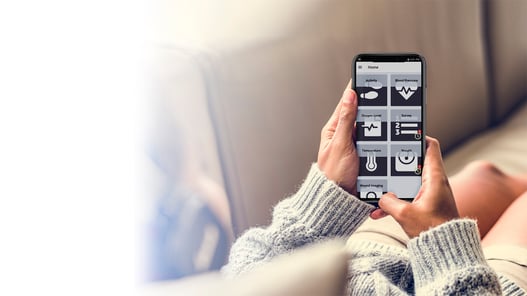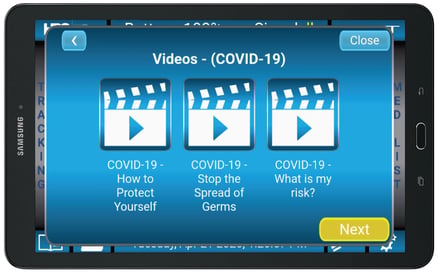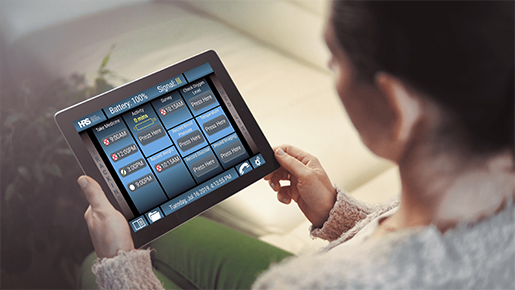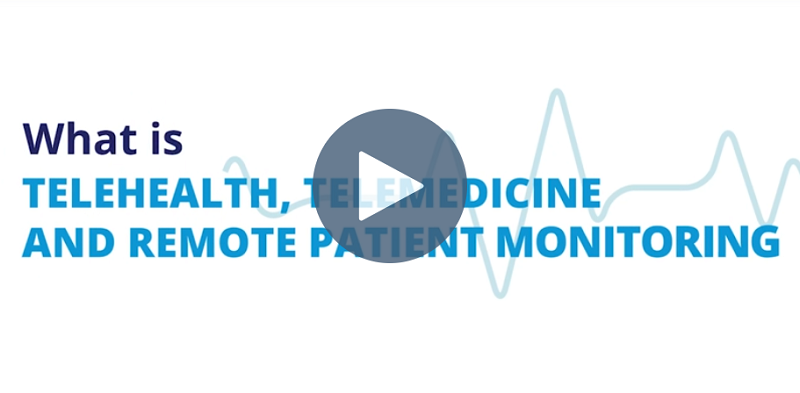Health Recovery Solutions
HRS PatientConnect Complete Use Case
Monitor your high-risk patients with PatientConnect Complete, HRS’ tablet and advanced biometric device offering. Respond to alerts when patients are at risk for readmission and communicate with patients in real-time through video, phone, and text chat. Improve patient engagement with condition-specific education, symptom surveys, medication reminders, and more.
- Chronic Care Management
- Hospital at Home
- Care Transitions
- Continuous Care


User Manuals & Other Information
An Introduction to HRS Product Support
Pragya Mathur
Perhaps one of HRS’ closest-knit teams, the Product Support team works every day (even weekends!) to provide top-tier support to HRS clients across the country.
To help shed some light on these hardworking team members, we (virtually) sat down with Nicole Cunha, the team lead, and Max Copeland, Product Support Engineer to discuss what really makes the Product Support team world class.
See the highlights of our conversation below!
What exactly does Top-Tier Support mean? What kind of tasks are you generally responsible for?
The Product Support (PS) team essentially acts as a bridge between the front-line Technical Support and the behind-the-scenes Product Management and Development teams. We receive escalations from Technical Support and Client Success, conduct high level investigations into the product’s behavior, and develop temporary workarounds for any issues while the Development team works on a long-term fix. We also act as the central communication point for clients and our internal teams regarding product investigations and general questions about product functionality.
The difference between Product Support and Technical Support:
Technical Support is responsible for helping clinicians and patients with the HRS product day-to-day, while the Product Support team works to resolve any issues that Technical Support is not able to resolve immediately.
What does a day in the life look like for the Product Support team?
Overall, each day on Product Support looks pretty different. However, every morning starts off with a daily Stand-Up meeting to discuss the most important tasks for the day and check in with each member of the team. This is our favorite part of the day! These meetings keep us connected, despite working remotely, and helps build camaraderie while helping each other on individual tasks.
Fun fact: the members of our Product Support team are spread out across 4 different states!
“Morning Stand up meetings are
the best part of our days.”
– Nicole Cunha, Product Support Team Lead
Throughout the day, the team follows up with clients and internal teams regarding product functionality and current investigations through emails, phone, and video calls. We also ensure that all communications are accurate, updated, and transparent. The Product Support team can often be found working closely with the Technical Support and Product Management teams to determine which tickets* need to be escalated and how.
*A ticket is any troubleshooting request that comes in via call or email from a clinician or patient.
What is one thing you would like HRS clients to know?
We truly believe in HRS’s mission and strive to put patients first! With every new investigation or project we take on, we really look at how the product functionality impacts patient experience and clinical workflows.
The Product Support team strongly values our partnership with HRS’s diverse clients. With every investigation, we’ve always found that our client’s feedback and observations into certain issues are just as important as our own findings. We truly respect the work our clients do and work hard to ensure they have the best possible experience with the HRS platform.
What is your favorite thing about being on the Product Support Team?
No two days are the same! Due to the variety of our daily tasks, we are constantly learning new things and thinking outside of the box while working on product improvements. Each day brings a new opportunity for individual members of the team to shine and further develop their own personal skills as we take on new projects. Given the uniqueness of our roles and flexibility of each team member, we are always excited to come together and tackle each day as a team.
“I like to think of our team as Swiss Army knife – where each member,
with their unique expertise, makes up a part of an effective tool.”
– Max Copeland, Product Support Engineer
Overall, the members of the Product Support team are HRS product experts and are a valuable resource for both our clients and internal teams.
Product Roadmap Q&A: HRS Chief Product Officer
Tess Meehan, MHA
1. We want to begin by looking back at 2020. Despite the challenges faced by healthcare providers, and possibly due in part to these challenges, numerous HRS clients saw significant growth in their telehealth and RPM programs. Was there anything in particular that jumped out at you?
First and foremost, the perseverance that we’ve seen from the clinicians we work with has been truly inspiring. For about a year now, healthcare providers have been faced with limited supplies and staffing shortages all while treating more patients at one time than they have ever had to before. We can see this reflected in the data; across HRS clients we saw a 92.9% increase in patients using the HRS platform, 173% increase in virtual visits, and 2.1 million COVID-19 symptom surveys submitted.
Along the same vein, our clients had to be really agile to meet the unique and ever-changing challenges presented by COVID-19. Throughout the course of 2020, we’ve seen over 100 clients launch new programs focused on preventing the spread of COVID-19 and ensuring the recovery of COVID-19 patients.

2. Considering what the healthcare industry has experienced and learned over 2020 and the COVID-19 pandemic, what are the key trends you see arising in 2021 and how does telehealth and RPM play a role in these trends?
There’s really four key trends that we’re seeing emerge in telehealth and RPM is essential to each one. The first is the movement to in-home care. Now, this has been slowly picking up pace over the past few years, but accelerated in 2020 due in no small part to COVID-19 and the need to free-up hospital resources as well as protect high-risk patients by treating them at home as opposed to in a hospital setting, skilled nursing facility, rehab environment, you name it. What we’ve seen over the past year is that the level of care a patient receives should not be determined by their location. Patients can receive this comprehensive, round-the-clock monitoring and support at their home.
Second, digital strategy has become an essential component to patients satisfaction. Patients are clamoring for digital health platforms – they’re actively choosing providers who offer these solutions over those who don’t. They have made it clear, they want to receive care in their home, and they want the tools to easily do that.
Third, clinicians now hold a dual role as providers and teachers. With digital health platforms come access to all these amazing tools but we need to educate clinicians on how to use the tools and how to in turn teach patients to use the tools and engage with the platform. Clinicians need to feel confident in their understanding of the technology and that requires building a platform that is intuitive and supporting that platform with the right educational materials.
Lastly, we have to maximize telehealth/RPM to recognize its full potential. Telehealth/RPM allows providers to free up bed capacity, establish more efficient paradigms, understand patients and their needs on a deeper level. But to do so, we have to be leveraging all of its capabilities.

3. HRS’ 2021 Product Roadmap draws from four key themes, can you describe the four themes and how they relate to the overarching mission of HRS?
The product roadmap that we’ve established for 2021 is informed by our strategic focus and fits into four core themes: securing the core, integration as a service, clinician experience, and patient experience.
The overarching mission of HRS shapes how we think about our product development and strategy. From the product and features we create to the services we offer, it all has to serve the larger mission of HRS – our three founding principles. One, serve as many patients as possible, providing innovative and individualized care. Two, increase clinical efficiency through intuitive tools and data-driven insights. Three, improve patients outcomes through best practice care plans and a user-friendly platform.
Looking at the four themes, they align with each of these founding principles. To serve as many patients as possible, we need to stabilize and scale our foundation – we need to secure the core. To increase clinical efficiency, we’re continuing to build upon our software integrations and the peripherals we offer, ensuring clinicians have a streamlined experience from end-to-end and across the multiple tech stacks they interact with each day. We’re also continuing to improve the functionality, design and reporting of our clinician-facing platforms to further enhance the clinician experience. Finally, to improve patient outcomes, we need to engage patients and involve them in their care. We do that by creating a seamless patient experience from the moment they open the box or download the app.

4. As the HRS Product Team built out the 2021 Product Roadmap, what role did client feedback play? And how impactful will client feedback be moving forward?
Feedback from our clients plays an enormous role in establishing our product roadmap, as well as our long term vision for HRS. Our team is constantly engaging with clients and assessing feature requests. As we continue to grow, so too will the role of our clients in determining our direction. To ensure we’re improving clinical efficiency and patient care – which again strikes at the heart of our mission – we need to understand our clients’ strategies, their goals, and their needs. Throughout 2021, we’ll be introducing new ways for our clients to submit their feedback and drive future innovations.
Similar Instructions

